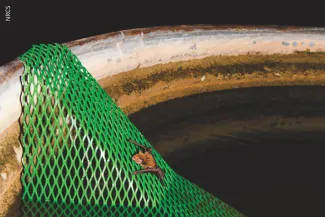Stock tanks are a familiar sight across Oklahoma, allowing producers to increase water availability to their livestock. A well-placed watering facility won’t just help livestock – a variety of wildlife species may also take advantage of an extra drink of water. And while these tanks offer many benefits, they may also become a source of danger for small mammals, birds, and reptiles. These smaller animals can sometimes fall in the tank, become trapped, and drown if the tanks aren’t equipped with escape ramps.
Mortality rates for these incidents aren’t reliably estimated, but evidence suggests wildlife drownings in stock tanks are frequent and widespread. These drownings not only affect the water quality for the livestock consuming water from these tanks, but also affect wildlife populations, especially those with low or declining populations. Thankfully, a simple, low-cost solution can help reduce the risk of wildlife drownings: wildlife escape ramps.

Wildlife-friendly escape ramps can be any structure that helps an animal escape after falling into water. Even so, the Natural Resources Conservation Service has found that piling rocks, leaving logs in the tank, or using a ramp that does not extend to the bottom of the tank is less effective. Instead, they offer several construction guidelines:
- The ramp should extend into the water and meet the inside wall of the trough so animals swimming along the perimeter will find the ramp, rather than becoming trapped behind or beneath it, or missing it entirely.
- Ramps should reach the bottom of the trough in case water levels drop.
- Ramps should be firmly secured to the trough rim, so it won’t be knocked loose by livestock or other animals.
- Ramps should be built using long-lasting materials with good traction, such as painted or coated metal grating, roughened fiberglass, concrete, rock and mortar, or high strength plastic composites.
- Slopes should be no steeper than 45 degrees so animals can climb out without slipping back into the water.
Several designs exist, but one of the most economical and easiest to construct is made of expanded metal grating. The ramp is built with 11- or 13-guage expanded metal with 0.5-inch mesh to create a ladder with adequate traction. Cut a square of expanded metal and bend it into the shape of a ramp that attaches to the tank rim, extends to the bottom of the tank, and has two sides that meet the side of the tank. The height should equal the depth of the tank. To maximize the life of the escape ramp, it should be finished with rust inhibiting paint or coating such as the enamel paint used for farm implements.
More information about escape ramps and their designs can be found in NRCS Biology Technical Note No. 43: Wildlife Escape Ramps